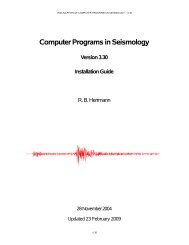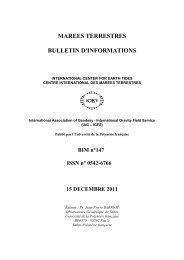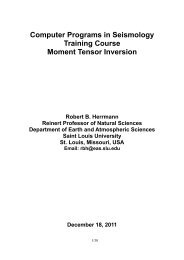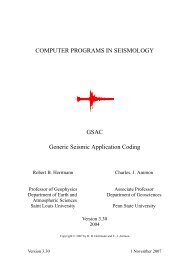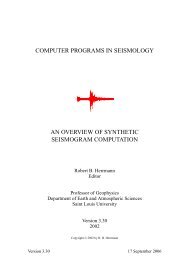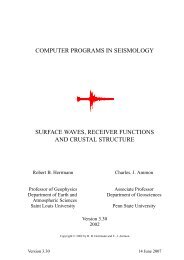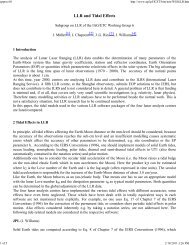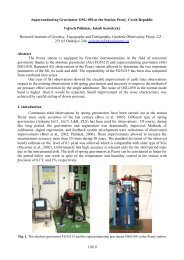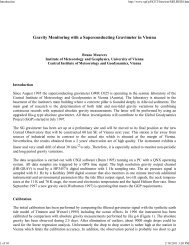3.04 Gravimetric Methods – Superconducting Gravity Meters
3.04 Gravimetric Methods – Superconducting Gravity Meters
3.04 Gravimetric Methods – Superconducting Gravity Meters
You also want an ePaper? Increase the reach of your titles
YUMPU automatically turns print PDFs into web optimized ePapers that Google loves.
104 <strong>Superconducting</strong> <strong>Gravity</strong> <strong>Meters</strong><br />
convective air motion (air mass exchange or water<br />
transport) does not alter the ground pressure (total<br />
air column mass unchanged) but does modify gravity<br />
through Newtonian attraction. This is an example<br />
where gravity could be of indirect use to meteorologists<br />
to indicate air movements without detectable<br />
ground pressure signature.<br />
<strong>3.04</strong>.3.4 Tides and Nearly Diurnal Earth<br />
Wobbles<br />
As discussed previously, Earth and ocean tides are by<br />
far the largest components of surface gravity changes.<br />
The SGs have brought two areas of improvement to<br />
tidal studies. First, the high sensitivity of these meters<br />
which enables them to detect small-amplitude tidal<br />
signals previously hidden in noise (e.g., nonlinear<br />
ocean tides) and to retrieve with better precision<br />
larger tidal signals (see Ducarme et al., 2002). With<br />
this high precision, Xu et al. (2004a) revisited the<br />
question of the possible latitude dependence of tidal<br />
gravimetric factors. Using 19 GGP stations they<br />
found that the discrepancy of the four principal<br />
waves (O 1 and K 1 in the diurnal band, M 2 and S 2 in<br />
the semi-diurnal band) between observations and<br />
theoretical models (Dehant et al., 1999; Mathews,<br />
2001) is less than 0.2%. This means that there is no<br />
significant latitude dependence. Second, the much<br />
lower instrumental drift of SGs versus mechanical<br />
spring meters permits more precise studies of long<br />
period tides (M f ,M m ,S Sa , and S a )(Sato et al., 1997a;<br />
Hinderer et al., 1998; Mukai et al., 2001; Ducarme<br />
et al., 2004; Boy et al., 2006).<br />
<strong>3.04</strong>.3.4.1 Resonance effects in diurnal<br />
tides<br />
Of the tides themselves, the largest components<br />
occur in both semi-diurnal and diurnal frequency<br />
bands. Within the diurnal band, some waves<br />
are affected by a resonance that occurs due to the<br />
nearly diurnal free wobble (NDFW), also called<br />
FCN, which is a differential rotation of the<br />
fluid outer core with respect to the mantle. In a corotating<br />
reference frame, the FCN period is of course<br />
nearly diurnal; in an absolute frame, it is approximately<br />
430 days. The observation of this resonance<br />
requires precise amplitude and phase measurements<br />
of the diurnal tidal waves that are close in frequency<br />
to the eigenfrequency. In particular, the smallamplitude<br />
waves c 1 and j 1 are critical in the retrieval<br />
of the FCN parameters, that is, the period and<br />
damping of this resonance mode. A very clear<br />
example of this can be found in Hinderer et al.<br />
(2000), where there is a noticeable improvement<br />
in the FCN adjustment when using data from<br />
the compact SG (C026) compared to earlier<br />
data from the TT70 in Strasbourg (see their<br />
figures 4 and 6).<br />
We do not discuss here the numerous papers using<br />
GGP data to derive the FCN parameters and refer<br />
the reader to previous reviews on this subject<br />
(Hinderer and Crossley, 2000, 2004). A study combining<br />
the analysis of six SGs by Sun et al. (2002)<br />
leads to an FCN period of 429.0 (424.3<strong>–</strong>433.7) sidereal<br />
days and a Q factor of 9500 (6400, 18 700). A<br />
more global analysis by Xu et al. (2004), who used<br />
simultaneously tidal gravity observations at 19 GGP<br />
stations, leads to an FCN period of 429.9 (427.2<strong>–</strong><br />
432.7) sidereal days and a Q value about 20 000<br />
(12 000<strong>–</strong>72 000). The FCN period is in good agreement<br />
with space geodetic studies (Herring et al., 1986;<br />
Neuberg et al., 1987; Merriam, 1994; Defraigne et al.,<br />
1994). However, most of the time, the gravityderived<br />
Q factor is much smaller than that obtained<br />
using VLBI (Herring et al., 1986). An artifact of the<br />
analysis is sometimes even a negative Q (see table 1 in<br />
Florsch and Hinderer (2000); Sun et al., 2002, 2004).<br />
The Q discrepancy between gravimeters and VLBI<br />
measurements is not due to imprecision in the gravity<br />
observations, but is rather of a methodological<br />
nature. The classical least-squares method usually<br />
applied to the determination of the resonance parameters<br />
(obviously, a linearized form applied to a<br />
nonlinear problem) is inadequate because it implies<br />
Gaussian statistics (Sato et al., 2002; Sun et al., 2004)<br />
that are not correct for this problem. Florsch and<br />
Hinderer (2000) have demonstrated that an appropriate<br />
Bayesian method is required to solve for the<br />
FCN parameters due to the nonstandard form of the<br />
probability distribution for Q.<br />
Figure 23 shows the Bayesian approach applied<br />
to Canberra (CB) SG data by plotting the joint<br />
probability distribution for the eigenperiod T and<br />
quality factor Q. Taking a vertical slice through the<br />
distribution shows that the shape is somewhat<br />
Gaussian for the period T, leading to values found<br />
in previous studies based on the least-squares<br />
method. This is no longer the case for a horizontal<br />
slice in which the distribution of Q shows a preferred<br />
range of high values exceeding 10 4 (including infinity<br />
which means no damping at all) in agreement<br />
with estimates from lunisolar nutation observations<br />
by VLBI.




